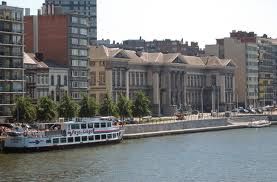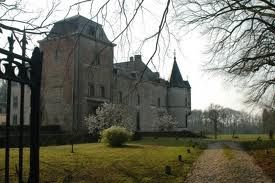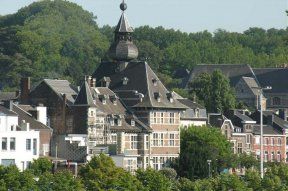(10 am. – promoted by ek hornbeck)
The Tour de France 2012, the world’s premier cycling event kicked off last Saturday with the Prologue in Liège, Belgium and will conclude on July 22 with the traditional ride into Paris and laps up and down the Champs-Élysées. Over the next 22 days the race will take its course briefly along the Northwestern coast of France through Boulogne-sur-Mer, Abbeville and into Rouen then into the mountains of the Jura, Swiss Alps and the Pyrenees.

Click on image to enlarge.
We will be Live Blogging Le Tour 2012 every morning at The Stars Hollow Gazette starting at 7:30 AM EDT. Come join us for a morning chat, cheer the riders and watch some of the most beautiful and historic countryside in Europe.
 Stage 1 began in Liège, where the Prologue took place Sunday. Liège is is situated in the valley of the Meuse River, near Belgium’s eastern borders with the Netherlands and Germany, where the Meuse meets the Ourthe. It is in the former sillon industriel, the industrial backbone of Wallonia. int the 8th century the Emperor Charlemagne was born in Liège.
Stage 1 began in Liège, where the Prologue took place Sunday. Liège is is situated in the valley of the Meuse River, near Belgium’s eastern borders with the Netherlands and Germany, where the Meuse meets the Ourthe. It is in the former sillon industriel, the industrial backbone of Wallonia. int the 8th century the Emperor Charlemagne was born in Liège.
The Main Sights
* The 16th century palace of the Prince-Bishops of Liège is built on the Place St Lambert, where the old St. Lambert’s Cathedral used to stand before the French Revolution. An archeological display, the Archeoforum, can be visited under the Place St Lambert.
* The perron on the nearby Place du Marché was once the symbol of justice in the Prince-Bishopric and is now the symbol of the city. It stands in front of the 17th century city hall.
* The present Liège Cathedral, dedicated to Saint Paul, contains a treasury and Saint Lambert’s tomb. It is one of the original seven collegiate churches, which include the German-Romanesque St Bartholomew’s Church (Saint Barthélémy) and the church of St Martin.
* The church of Saint-James (Saint-Jacques) is probably the most beautiful medieval church in Liège. It is built in the so-called Flamboyant-Gothic style, while the porch is early Renaissance. The statues are by Liège sculptor Jean Del Cour. Saint-Jacques also contains 29 spectacular 14th century misericords.
* The main museums in Liège are: MAMAC (Museum of Modern & Contemporary Art), Museum of Walloon Life, and Museum of Walloon Art & Religious Art (Mosan art). The Curtius Museum is an elegantly furnished mansion from the 17th century along the Meuse River, due to reopen in March 2009 as the expanded Grand Curtius museum housing the collections of the archaeology, decorative arts, religious art and Mosan art museums.
* Other sites of interest include the historical city centre (the Carré), the Hors-Château area, the Outremeuse area, the parks and boulevards along the Meuse river, the Citadel, the 400 steps stairway “Montagne de Bueren”, leading from Hors-Château to the Citadel, ‘Médiacité’ shopping mall designed by Ron Arad Architects and the Liège-Guillemins railway station designed by Santiago Calatrava.
 The race ended 198 km later in Seraing, Belgium. The municipality of Seraing includes the old communes of Boncelles, Jemeppe-sur-Meuse, and Ougrée. With Liège, Herstal, Saint-Nicolas, Ans, and Flémalle it forms the greater Liège agglomeration (600,000 inhabitants). To the south of Seraing are the Condroz, followed by the Ardennes region.
The race ended 198 km later in Seraing, Belgium. The municipality of Seraing includes the old communes of Boncelles, Jemeppe-sur-Meuse, and Ougrée. With Liège, Herstal, Saint-Nicolas, Ans, and Flémalle it forms the greater Liège agglomeration (600,000 inhabitants). To the south of Seraing are the Condroz, followed by the Ardennes region.
In addition to its steel factories, Seraing counts a famous crystal manufacture at Val Saint Lambert, which has been operating on the site of an old Cistercian abbey since 1826. The site of the Arcelor steel company, previously known as Cockerill-Sambre, is the former summer residence of the prince-bishops of Liège.
* The Val Saint Lambert site includes the old abbey and the crystal manufacture, where glass workers still blow, carve, and etch the world-famous pieces of art. The neighbouring castle houses a glass museum.
* The Cockerill castle used to be the summer residence of the prince-bishops of Liège, then a hospital under Napoleon, a powder magazine, and the personal property of William I of the Netherlands, who ceded it to the Cockerill family in 1817.
* Besides the Cockerill castle, the historic centre of the city also includes the city hall and the main church, which harbours 12th-century baptismal fonts.
* The forested region south of Seraing offers a multitude of strolls and hikes.
Today Stage also began in Belgium, starting in Visé and ending in Tournai after 207.5 km of mostly flat route. Strategists see this part of the course as tailored to the sprinters. This is the first time that Vise will host Le Tour.
At the 82 km point the bikers will visit the citadel of Namur with a 2.1 kilometre-long climb at 4.5%.
 Capital of the Lower Meuse, the only French-speaking city to have a shared border with the Netherlands, Visé is midway between Liege and Maastricht. This location has enabled it to develop its importance as a transportation hub and at the same time increase its tourist numbers thanks to a rich heritage. These include in particular the Town Hall built in the seventeenth century whose bulbous steeple rises to over thirty meters and whose chimes ring with the life of the city every quarter of an hour, the Collegiate and its Gothic choir, the Perron , once a symbol of authority of the Prince-Bishops of the Principality of Liege or even the shrine of Saint Hadelin, jewel of 11th century Mosan art. Visé, which also includes three guilds of crossbowmen and arquebusiers, is also nicknamed the City of the Goose. This relates to a traditional recipe where the bird is cooked in a vegetable stock before being covered in a garlic sauce. Market town but also a city of leisure, traditions, culture and sport, life is good in Visé.
Capital of the Lower Meuse, the only French-speaking city to have a shared border with the Netherlands, Visé is midway between Liege and Maastricht. This location has enabled it to develop its importance as a transportation hub and at the same time increase its tourist numbers thanks to a rich heritage. These include in particular the Town Hall built in the seventeenth century whose bulbous steeple rises to over thirty meters and whose chimes ring with the life of the city every quarter of an hour, the Collegiate and its Gothic choir, the Perron , once a symbol of authority of the Prince-Bishops of the Principality of Liege or even the shrine of Saint Hadelin, jewel of 11th century Mosan art. Visé, which also includes three guilds of crossbowmen and arquebusiers, is also nicknamed the City of the Goose. This relates to a traditional recipe where the bird is cooked in a vegetable stock before being covered in a garlic sauce. Market town but also a city of leisure, traditions, culture and sport, life is good in Visé.
 Crossed by l’Escaut, Tournai is one of the oldest cities in Belgium. Near Brussels, Paris and London, a veritable crossroads of cultures, it has been under French, Austrian, Spanish and English control in the past. Testament to its past, the Notre Dame Cathedral and the Belfry, symbols of spiritual and temporal powers, are UNESCO World Heritage Sites. A country town (Tournai as a whole is composed of twenty-nine villages), Tournai invites you to discover the museum of Fine Art where the only two paintings by Manet are kept in Belgium. Fabulous works in a setting that is even more special since it was the only museum designed by renowned architect Victor Horta. Fourth largest city of Belgian Hainaut, Tournai invites you to stroll along the banks of the Escaut, whilst the Mont-Saint-Aubert, its highest point, is a paradise for cyclists and poets. Tournai is also part of the Lille-Kortrijk-Tournai Eurometropolis, the European grouping of territorial cooperation at the heart of a community with more than two million inhabitants.
Crossed by l’Escaut, Tournai is one of the oldest cities in Belgium. Near Brussels, Paris and London, a veritable crossroads of cultures, it has been under French, Austrian, Spanish and English control in the past. Testament to its past, the Notre Dame Cathedral and the Belfry, symbols of spiritual and temporal powers, are UNESCO World Heritage Sites. A country town (Tournai as a whole is composed of twenty-nine villages), Tournai invites you to discover the museum of Fine Art where the only two paintings by Manet are kept in Belgium. Fabulous works in a setting that is even more special since it was the only museum designed by renowned architect Victor Horta. Fourth largest city of Belgian Hainaut, Tournai invites you to stroll along the banks of the Escaut, whilst the Mont-Saint-Aubert, its highest point, is a paradise for cyclists and poets. Tournai is also part of the Lille-Kortrijk-Tournai Eurometropolis, the European grouping of territorial cooperation at the heart of a community with more than two million inhabitants.
 Côte de la Citadelle de Namur Namur began as an important trading settlement in Celtic times, straddling east-west and north-south trade routes across the Ardennes. The Romans established a presence after Julius Caesar defeated the local Aduatuci tribe.
Côte de la Citadelle de Namur Namur began as an important trading settlement in Celtic times, straddling east-west and north-south trade routes across the Ardennes. The Romans established a presence after Julius Caesar defeated the local Aduatuci tribe.
Namur came to prominence during the early Middle Ages when the Merovingians built a castle or citadel on the rocky spur overlooking the town at the confluence of the two rivers. In the 10th century it became a county in its own right. The town developed somewhat unevenly, as the counts of Namur could only build on the north bank of the Meuse – the south bank was owned by the bishops of Liège and developed more slowly into the town of Jambes (now effectively a suburb of Namur). In 1262, Namur fell into the hands of the Count of Flanders, and was purchased by Duke Philip the Good of Burgundy in 1421.
After Namur became part of the Spanish Netherlands in the 1640s, its citadel was considerably strengthened. Louis XIV of France invaded in 1692, capturing the town and annexing it to France. His renowned military engineer Vauban rebuilt the citadel. French control was short-lived, as William III of Orange-Nassau captured Namur only three years later in 1695 during the War of the Grand Alliance. Under the Barrier Treaty of 1709, the Dutch gained the right to garrison Namur, although the subsequent Treaty of Utrecht of 1713 gave control of the formerly Spanish Netherlands to the Austrian House of Habsburg. Thus, although the Austrians ruled the town, the citadel was controlled by the Dutch. It was rebuilt again under their tenure.
France invaded the region again in 1794, during the French Revolutionary Wars, and again annexed Namur, imposing a repressive regime. After the defeat of Napoleon in 1815, the Congress of Vienna incorporated what is now Belgium into the United Kingdom of the Netherlands. Belgium broke away from the Netherlands in 1830 following the Belgian Revolution, and Namur continued to be a major garrison town under the new government. The citadel was rebuilt yet again in 1887.
Namur began as an important trading settlement in Celtic times, straddling east-west and north-south trade routes across the Ardennes. The Romans established a presence after Julius Caesar defeated the local Aduatuci tribe.
Namur came to prominence during the early Middle Ages when the Merovingians built a castle or citadel on the rocky spur overlooking the town at the confluence of the two rivers. In the 10th century it became a county in its own right. The town developed somewhat unevenly, as the counts of Namur could only build on the north bank of the Meuse – the south bank was owned by the bishops of Liège and developed more slowly into the town of Jambes (now effectively a suburb of Namur). In 1262, Namur fell into the hands of the Count of Flanders, and was purchased by Duke Philip the Good of Burgundy in 1421.
After Namur became part of the Spanish Netherlands in the 1640s, its citadel was considerably strengthened. Louis XIV of France invaded in 1692, capturing the town and annexing it to France. His renowned military engineer Vauban rebuilt the citadel. French control was short-lived, as William III of Orange-Nassau captured Namur only three years later in 1695 during the War of the Grand Alliance. Under the Barrier Treaty of 1709, the Dutch gained the right to garrison Namur, although the subsequent Treaty of Utrecht of 1713 gave control of the formerly Spanish Netherlands to the Austrian House of Habsburg. Thus, although the Austrians ruled the town, the citadel was controlled by the Dutch. It was rebuilt again under their tenure.
France invaded the region again in 1794, during the French Revolutionary Wars, and again annexed Namur, imposing a repressive regime. After the defeat of Napoleon in 1815, the Congress of Vienna incorporated what is now Belgium into the United Kingdom of the Netherlands. Belgium broke away from the Netherlands in 1830 following the Belgian Revolution, and Namur continued to be a major garrison town under the new government. The citadel was rebuilt yet again in 1887.
Click on first two images to enlarge.





1 comments
Author